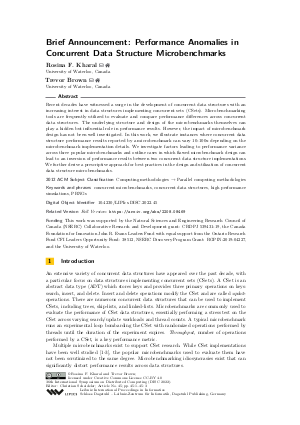Brief Announcement: Performance Anomalies in Concurrent Data Structure Microbenchmarks
Authors Rosina F. Kharal, Trevor Brown
-
Part of:
Volume:
36th International Symposium on Distributed Computing (DISC 2022)
Part of: Series: Leibniz International Proceedings in Informatics (LIPIcs)
Part of: Conference: International Symposium on Distributed Computing (DISC) - License:
 Creative Commons Attribution 4.0 International license
Creative Commons Attribution 4.0 International license
- Publication Date: 2022-10-17
File

PDF
LIPIcs.DISC.2022.45.pdf
- Filesize: 473 kB
- 3 pages
Document Identifiers
Related Versions
- Full Version https://arxiv.org/abs/2208.08469
Subject Classification
ACM Subject Classification
- Computing methodologies → Parallel computing methodologies
Keywords
- concurrent microbenchmarks
- concurrent data structures
- high performance simulations
- PRNGs
Metrics
- Access Statistics
-
Total Accesses (updated on a weekly basis)
0PDF Downloads0Metadata Views
Abstract
Recent decades have witnessed a surge in the development of concurrent data structures with an increasing interest in data structures implementing concurrent sets (CSets). Microbenchmarking tools are frequently utilized to evaluate and compare performance differences across concurrent data structures. The underlying structure and design of the microbenchmarks themselves can play a hidden but influential role in performance results. However, the impact of microbenchmark design has not been well investigated. In this work, we illustrate instances where concurrent data structure performance results reported by a microbenchmark can vary 10-100x depending on the microbenchmark implementation details. We investigate factors leading to performance variance across three popular microbenchmarks and outline cases in which flawed microbenchmark design can lead to an inversion of performance results between two concurrent data structure implementations. We further derive a prescriptive approach for best practices in the design and utilization of concurrent data structure microbenchmarks.
Cite As Get BibTex
Rosina F. Kharal and Trevor Brown. Brief Announcement: Performance Anomalies in Concurrent Data Structure Microbenchmarks. In 36th International Symposium on Distributed Computing (DISC 2022). Leibniz International Proceedings in Informatics (LIPIcs), Volume 246, pp. 45:1-45:3, Schloss Dagstuhl – Leibniz-Zentrum für Informatik (2022)
https://doi.org/10.4230/LIPIcs.DISC.2022.45
BibTex
@InProceedings{kharal_et_al:LIPIcs.DISC.2022.45,
author = {Kharal, Rosina F. and Brown, Trevor},
title = {{Brief Announcement: Performance Anomalies in Concurrent Data Structure Microbenchmarks}},
booktitle = {36th International Symposium on Distributed Computing (DISC 2022)},
pages = {45:1--45:3},
series = {Leibniz International Proceedings in Informatics (LIPIcs)},
ISBN = {978-3-95977-255-6},
ISSN = {1868-8969},
year = {2022},
volume = {246},
editor = {Scheideler, Christian},
publisher = {Schloss Dagstuhl -- Leibniz-Zentrum f{\"u}r Informatik},
address = {Dagstuhl, Germany},
URL = {https://drops.dagstuhl.de/entities/document/10.4230/LIPIcs.DISC.2022.45},
URN = {urn:nbn:de:0030-drops-172363},
doi = {10.4230/LIPIcs.DISC.2022.45},
annote = {Keywords: concurrent microbenchmarks, concurrent data structures, high performance simulations, PRNGs}
}
Author Details
Funding
This work was supported by the Natural Sciences and Engineering Research Council of Canada (NSERC) Collaborative Research and Development grant: CRDPJ 539431-19, the Canada Foundation for Innovation John R. Evans Leaders Fund with equal support from the Ontario Research Fund CFI Leaders Opportunity Fund: 38512, NSERC Discovery Program Grant: RGPIN-2019-04227, and the University of Waterloo.
References
-
Maya Arbel-Raviv, Trevor Brown, and Adam Morrison. Getting to the root of concurrent binary search tree performance. In 2018 USENIX Annual Technical Conference, 2018.

-
Trevor Brown, Aleksandar Prokopec, and Dan Alistarh. Non-blocking interpolation search trees with doubly-logarithmic running time. In Proceedings of the 25th ACM SIGPLAN Symposium on Principles and Practice of Parallel Programming, 2020.

-
Tudor David, Rachid Guerraoui, and Vasileios Trigonakis. Asynchronized concurrency: The secret to scaling concurrent search data structures. In Proceedings of the Twentieth International Conference on Architectural Support for Programming Languages and Operating Systems, 2015.

-
Vincent Gramoli. More than you ever wanted to know about synchronization: Synchrobench, measuring the impact of the synchronization on concurrent algorithms. In Proceedings of the Symposium on Principles and Practice of Parallel Programming, pages 1-10, 2015.

-
Aravind Natarajan and Neeraj Mittal. Fast concurrent lock-free binary search trees. In Proceedings of the 19th ACM SIGPLAN Symposium on Principles and Practice of Parallel Programming, PPoPP '14, 2014.

